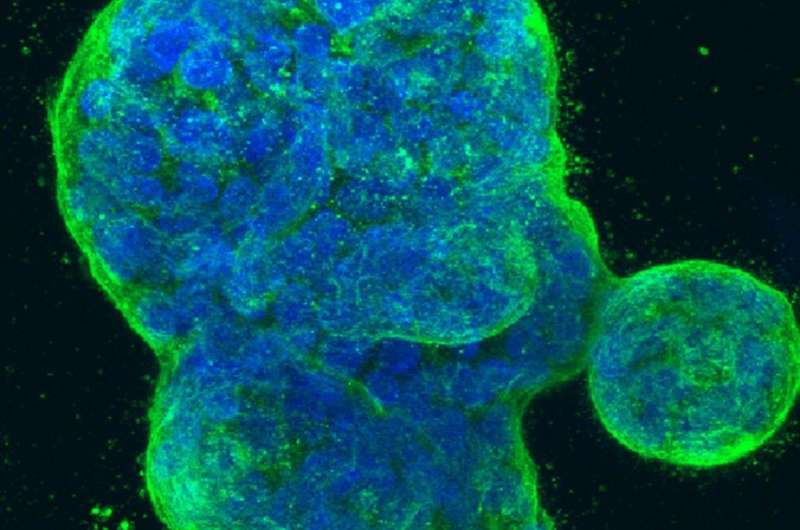
Adding an immune checkpoint inhibitor to anti-HER2 treatment in breast cancer does not improve pathological complete response (pCR), according to the primary analysis of the IMpassion050 trial presented today during the ESMO Virtual Plenary. The phase III trial is the first to report data comparing a neoadjuvant anti-HER2 based regimen with or without the anti-PD-L1 antibody atezolizumab in patients with high-risk, HER2-positive early breast cancer.
The standard treatment for high-risk, HER2-positive early breast cancer is dual anti-HER2 blockade plus chemotherapy. While antibody therapy may enhance innate and adaptive immunity and activate cellular cytotoxicity, there is evidence that combination with a checkpoint inhibitor may further enhance the immune response. IMpassion050 evaluated the efficacy and safety of neoadjuvant atezolizumab versus placebo in patients receiving dose-dense anthracycline and taxane-based chemotherapy as a sequential treatment in combination with the antibodies pertuzumab and trastuzumab.
The trial enrolled 454 patients with high-risk HER2-positive early breast cancer, meaning they had a primary breast tumor size of >2 cm, and pathologic confirmation of nodal involvement. Patients were randomly allocated in a 1:1 ratio to the two treatment arms and received six months of neoadjuvant therapy. Following surgery, patients resumed their allocated treatment with atezolizumab versus placebo. Patients with pCR continued pertuzumab and trastuzumab while those with residual disease could switch to trastuzumab emtansine (T-DM1).
The co-primary endpoints were pCR in the intention to treat (ITT) and PD-L1 positive populations. Event-free survival (EFS), overall survival and safety were secondary endpoints. The trial was stopped prematurely when the Independent Data Monitoring Committee judged that there was an unfavorable benefit-risk profile with the intervention. The data were analyzed early, with three patients still to undergo surgery.
In the ITT population, pCR was achieved by 62.4% of the atezolizumab arm and 62.7% of the placebo arm (p=1.0). In the PD-L1 positive population, pCR was achieved by 64.2% of the atezolizumab arm and 72.5% of the placebo arm (p=0.2). Regarding safety, there were higher rates of grade 3/4 adverse events (AEs; 51.8% versus 43.6%) and serious AEs (19.5% versus 13.3%) in the neoadjuvant phase with atezolizumab versus placebo, respectively. During neoadjuvant treatment, four patients in the atezolizumab group died compared to no patients in the placebo group. Of the four deaths, two fatal events were assigned to study treatment—one due to alveolitis and one due to septic shock, although it is not clear whether these were immune-related.
Lead author Prof Jens Huober, professor of gynecologic oncology at the Breast Centre St. Gallen, Switzerland, said, “Overall, the safety profile was consistent with other combination studies with atezolizumab, with no new side effects. It is important to note that this was a selected population of high-risk HER2-positive patients to justify the potential toxicity of the additional drug and because patients with HER2-positive, node negative, smaller tumors do well with standard treatment.”
Huober added, “The additional immunotherapy in this setting did not enhance the pCR rate in the overall population or in any subgroup. However, what counts for patients are EFS and overall survival (OS), which were secondary endpoints, and we need longer follow-up for those results. In addition, there is some evidence in triple negative breast cancer that pCR may not be the best endpoint for measuring the efficacy of immunotherapy.”
Commenting on the study, Dr. Carmen Criscitiello, scientist and senior physician at the European Institute of Oncology in Milan, Italy said, “At trial level pCR is not a robust and validated endpoint for efficacy so the findings should be interpreted with caution until there are long-term results on EFS. In triple negative breast cancer, immune checkpoint inhibition added to standard neoadjuvant therapy modestly increased pCR rate in the GeparNUEVO and KEYNOTE-522 studies—yet EFS was significantly improved in both studies.”
Criscitiello added, “In the metastatic setting, the benefit of adding an immune checkpoint inhibitor to chemotherapy is largely confined to the PD-L1 positive population. In the neoadjuvant setting, benefit in patients with triple negative breast cancer has been observed in the overall population and in both PD-L1 positive and negative subgroups. In the IMpassion050 PD-L1 positive group, the pCR rate was numerically inferior in the experimental arm compared to the control arm, suggesting a numerical opposite trend in PD-L1 negative tumors. This indicates the need to better investigate biological differences on the impact of PD-L1 by disease setting.”
Source: Read Full Article
